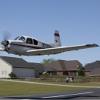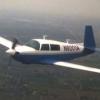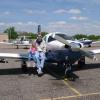Leaderboard
Popular Content
Showing content with the highest reputation on 12/10/2017 in all areas
-
When a single engine is certified it needs to be recoverable within one turn after anti-spin controls are applied. The spin test is done with full aft cg and full fuel as was the case for the long range tanks STC. The test was done at 10,000ft on 49 possible configurations. Even though the Mooney recovered within a 1,000ft I found this test of little value since most spin accidents occur on approach or departure at low speed and low altitude. José5 points
-
I have been Bartman for a long time. Friends call me Bartman and it stuck so I chose Bartman from the Simpsons as my Avitar. Some time ago a cherished couple we have been friends with since residency asked for a picture of me in the airplane. They gave me a present, a personalized bobble headed Mini-me sitting in an airplane. Although I will keep Bartman as my alter ego, it's time for a change of my avitar.3 points
-
I too have a WX1000 in my little E. I rarely use it, but it is worth its weight in gold when I do need it. As others have said, it is real time. One other thing I have found is that it will depict a developing cell, while nexrad may not see it yet because there is not yet visible moisture. This is not quite the same as the delay in nexrad, it just doesn’t see it, while the storms scope may pick up on the advanced electrical activity. I wish I had pictures like the others do, but I have observed it numerous times while flying visual down south. I think the storm scope is a nice compliment to FIS-B or XM.3 points
-
3 points
-
I agree with you. In reading everyone’s post I find it odd that simple request for information about aircraft performance turned into some of these folks criticizing the way others fly AND assuming that anyone that asks a question is going to automatically be making poor risk decisions and telling them what to do. Did anyone think that the person asking the original question might have over 10,000 hours in a wide variety of aircraft and every type of weather and regional conditions. You get to that level of flying by making smart choices. Kind of like asking about performance of aircraft before buying it. You don’t just jump in without looking. Sent from my iPhone using Tapatalk2 points
-
It makes the difference between living and dying in a clean airplane like this. Nobody recovers from a 350 knot, 8-g vertical barrel roll. If the gear was already down, it greatly reduces this outcome But this thread was about lowering the gear in a spin to help recover. I think I would have rather used my additional brain power to first avoid a spin, and second, to recover using the PARE technique which is sound and works.2 points
-
Living in WV, I found the old electric leaf blower would move about an inch of dry snow in the driveway and off the car. It did pretty much nothing for wet snow.2 points
-
Recently met an experienced aerobatic pilot who related that he’d spun a Mooney years ago “to see what it would do” and had time to ponder the wisdom of that choice while his anti-rotation rudder inputs had no affect. He said he was able to arrest rotation but only after jockeying power and putting gear down. Another log in the quite substantial “don’t spin a Mooney” bonfire... Sent from my iPhone using Tapatalk2 points
-
What we do, as pilots, is manage risk in relation to a mission. If that level of risk is acceptable, we fly, otherwise we cancel. I wouldn’t fault someone for recognizing that they will only accept Day, vmc flying any more than I would someone who stays current and proficient and flys routine hard IMC missions. I would certainly fault someone for trolling around hard IMC, single engine, over mountains, at night, if they only keep the bare minimum proficiency required for an IFR ticket, and hadn’t spent any time in hard IMC over the past 12 or so months. Accepting that level of risk seems high for me, even though it’s legal, as the pilot is not as proficient as they probably should be to fly that mission. Personally, I avoid carrying my family over mountains at night in IMC, although I don’t hesitate to do that mission if it’s just me in the plane. My risk matrix changes when my family is onboard. And I fly quite a bit in hard IMC, and execute far more than the requirements to keep IFR proficiency. Be happy you’re not paid to fly... there are times I’m forced to accept more risk than I’d like to, personally. But that’s why I’m paid in government cheese, I suppose. It gives me a healthy respect for the weather, too I guess. their will always be people that will “judge you” without thought as to why or how another would operate (this is common in anything in life). It is simple, though... assess how much risk you’re willing to accept, plan and fly accordingly. If your computations are correct, you’ll have a long, fruitful flying career. so... long story just to say that I agree with you. If you’re good for it, then do it.2 points
-
Gentlemen: I wanted to circle back and let you know that, as a result of your experiences, we were able to replace the limit switches at a cost of $30 vs the entire preselect relay board for $1700. The flaps worked flawlessly all day in my flight (city, desert, and ocean) across Oregon. A big thanks for everyone who commented here. Sent from my iPhone using Tapatalk2 points
-
2 points
-
Finally got back up in the air after a few weeks. The 830 works great and the SL-40 that was put in sounds amazing compared to what I was using. The new Zeftronics VR probably is playing a role in that as well. The generator that they put in also charges so I'm all set for more flying. It was bumpy for the couple trips I took around the pattern to check everything out, winds 040 10G19 for runway 07. Best part of it was seeing this paint job at the field.2 points
-
2 points
-
Preferred ground transportation will be front or 4-wheel drive. Tires will be marked M+S For mud and snow... NJ only gets a few days like this in a year... -a-2 points
-
Let me start with that the main difference between FIS-B weather and the StormScope is that the latter is current activity and the former can have some delays in it. Weather on FIS-B is precipitation (I think I read somewhere lighting information is or might be coming) but you need to remember that what you are seeing on your iPad may be dated and making a weather decision on that can be a hazard to you. AOPA posted a video on an accident where this happened in Texas. The older lightning detection stuff had some limitations. One of the biggest was radial spread. This equipment picks up electrical discharges. On my old WX-8, if a strong storm was 80 miles out, it would light up all of the quadrants from 0 miles out to full scale. Sort of like this: The newer stuff like my WX-500 has both a strike and cell mode. The cell mode is useful because it shows clusters of lightning activity which are commonly found in thunderstorms. Here is a shot of a storm that is out 100 miles from my plane. The StormScope is shown in cell mode (+ signs are used to denote cell activities) and you will see a rate count of these strikes. The higher the number, the more active it is. This storm is a long way out and not very active, although it was in a building mode and I deviated. Here is a good example of a storm that has no lightning activity but just heavy rain. This is what I am seeing on my iPad using actual internet weather from my cell phone: This is what is showing on my Aspen MFD. The MFD is showing the same weather as the internet weather showing on my iPad but it is FIS-B being fed in from my Lynx 9000. There is no lightning activity as indicated by the lack of strikes on the MFD and a “0” rate shown on the bottom of the MFD display: And this is what it looked like out the window. If you were flying in clouds at this point and only saw the FIS-B display you probably would have deviated. The StormScope gives you more information that helps you understand what you are dealing with. Hope this helps: Sent from my iPad using Tapatalk Pro2 points
-
In a graveyard spiral, you’re still in controlled flight- I think the biggest risk recovering from that would be over stressing the plane, and structurally destroying it (in flight break up). The gear would act as a big speed rake- so if altitude was a consideration, I think deploying the gear (knowingly over speeding it in the process) could actually be a smart decision and allow you to get below corner velocity (maneuvering speed), thus allowing a safe recovery of the airplane. The biggest problem with a graveyard spiral, though, is typically the pilot doesn’t realize they are in one (inadvertent flight into imc, then “listening” to your vestibular system as opposed to flying the instruments). It’s the moment you pop out of the goo and see that you’re 60 degrees nose low in a turn that you snatch the controls and destroy your plane. AOPA safety institute has an awesome and terrifying video about a pilot of a pilatus with his family on board that does just this... the autopilot kicks off and he didn’t recognize what was going on until it was too late- then snatched the yoke back and tore the tail and wings off the plane... at 18000’. He had the rest of his life (about 45 seconds) to contemplate how he’d killed himself and his family.1 point
-
IAS in the spin is very low. Remember the airplane is stalled. I’m not sure if the drag from the gear extending will make any difference.1 point
-
Andy, I have no good answer... but, to add to the depth of your question.... Have you seen the picture of the fifth person sitting in the baggage compartment of the fully loaded M20C before the off-field landing..? Fortunately, somebody has done this test flight already, shared the visuals of it, and now we have an answer to 'what happens if I do this...' Best regards, -a-1 point
-
Antares, I know it wasn't your video, so this isn't directed at you, but why would someone post a video where they are: 1.) breaking an FAR (not wearing an installed shoulder harness during takeoff and landing) 2.) allowing their airplane to get into a spin and 3.) executing an improper spin recovery (didn't retard throttle to idle, especially because his incipient spin was to the left) What a dumbass.1 point
-
@TargetDriver, like Peter I like the stand alone display. You might want to try a search for several threads on Stormescopes vs. other on board weather info. I have a WX 900 and trust it completely to keep me out of trouble. This pic of the GTN shows some cloud cover and a lot of traffic in addition to navigation info - pretty cluttered.1 point
-
+1 for QT Halo's $300, and if you don't like the foam ear buds, I got custom made ear molds from an audiologist for about $80. I've got an $1100 set of Zulu2's that ride around in the back seat for passengers. They're just not nearly as quiet or comfortable as the Halo's.1 point
-
The G5 a certified as a primary attitude indicator only. It can also replace the turn coordinator as long as the original attitude indicator remains. But the G5 STC specifically allows it to be used as either a primary AI or as a back up for the existing attitude indicator , and the G500 and G600 STC specifically only allow certain models of back ups for them as well. Same thing with Aspen. So go ahead and install it, just bring approved data. I’m not sure how I would provide that. Theres also this.1 point
-
1 point
-
Headsets, Inc. sells an electrical connector that can be hardwired into the plane's power, to avoid the battery problem. I only use their battery pack when I flying with someone else in their plane.1 point
-
We may be mixing topics. The gear out discussion ,in my mind ,was for what is popularly known as the graveyard spiral. This is when speed is building like crazy and for whatever reason you can’t get the wings level and the nose up....perhaps due to tumbled instruments. Then again, at that point putting out the gear may not be the first thing you think of. Regarding CG, I was just suggesting that theoretically your CG moves forward, not suggesting that it would be a substantial help in a spin. It would be very subtle, only the weight of the nose gear moves forward. I think the discussion started with “more retractable breaking up after loss of control in IMC”. I think one Would need to investigate other factors. Higher performance planes tend to be used more for serious travel which leads to more serious weather. Retractables pick up Speed faster when departing level flight than fixed gear, giving less time to respond, etc. I also think that they are comparing to Brand B. There have been far more in flight breakups of brand P than Mooney’s. Regarding loss of control, not sure, but I think they should have data before suggesting that retractables have more loss of control than fixed gear, really need to compare IMC hours and that is near impossible.1 point
-
I don't try to do the math on what is cheaper... It's convenience and that I love to fly. Fortunately my wife does too. She flew Delta recently to Salt Lake to see the grandkids because she had some credits to use. She was texting me from the terminal while waiting to board wishing she was in our Mooney.1 point
-
I assume this is totally academic. I’ve spun a lot of planes (did all my faa required spins inverted ) but never a Mooney of course. I wouldn’t let gear be a distraction and immediately do your PARE. Maybe if you had a sic he could concern himself with gear -Robert1 point
-
I've read / heard that lowering the gear is a generally acknowledged step when you have lost control. Nothing will help a spin in the pattern, there's not enough altitude . . .1 point
-
It should really only happen at the fringe area of WAAS coverage. I've reported loosing LPV200 service on the west coast a couple of times but that hasn't happened since the temporary period when we were down to a single WAAS satellite. That was quite some time ago. These days the fringe area is generally well beyond the coast lines. You can see the current real time status here: http://www.nstb.tc.faa.gov/ with many options including historical data. Highly unlikely a it was normal to loose LPV at KSAC but possible. Yet you can even run a video that shows the status changing over time and see what was going on when you were in the air.1 point
-
1 point
-
Flying in the mountains at night in the wintertime I think there are more important considerations than speed and fuel flow.. Like whether you should be doing it at all.1 point
-
I wonder if you can buy three of these and replace the castor wheels with the sort that are big and pneumatic. Would make it so much easier to move this around on a semi-hard surface. Or if you are a CB like me, I would put the tires on a piece of plywood into big black farm tubs and then slide it around through the gate with YooperMan’s technique. OR slide with: Sent from my iPhone using Tapatalk1 point
-
My son's flight from Orlando to Atlanta to Knoxville got delayed hours before being cancelled. We had him take an Uber to catch a flight leaving Tampa to Newark to knoxville. I was worried about snow in Newark but they seem to be managing. He's still taxiing on the final leg but at least he's on the plane.1 point
-
Wow ultimate post hijack. Back to Mooney F and J discussion please? Geez. Sent from my iPhone using Tapatalk1 point
-
I rationalize cost thus: Since I already pay the fixed costs whether I fly or not, I can go fly for an hour, shoot an approach or two, cruise around some, and land back at my Home airport all for about $100. (30 gallons of JetA at around $3) So I tell myself it’s cheaper to fly a turboprop than renting a beat up 172 at the Flight School. (No, thanks for your kind offer but I already own the Brooklyn Bridge)1 point
-
I hope I’m never given one. I would miss the self fellatio every time I change tanks.1 point
-
Yep. That was my aircraft. I missed all of the fun, it sound like! I would have helped you measure. I did talk to the airport staff for a while and they mentioned the fence as a formidable problem.... There was a nice Gulfstream sitting on the ramp next to my aircraft when I left. Was that yours? Definitely a small world. Glad you and yours are ok. Nice work putting her back down in the field.1 point
-
You haven't provided enough detail. Should the explosives be used to make the gate bigger or the plane smaller? Either of those solve the problem.1 point
-
Times like this is really wish I had paid more attention in Geometry...instead of staring out the window and daydreaming about airplanes.1 point
-
Had a couple interesting moments in 10 hours of flying this weekend with controllers. I got my clearance to Spruce Creek (south of Daytona Beach) on the ramp at KOSU (Ohio State University Airport, just outside Columbus OH). I had filed FL270 and was given 3,000', expect 270 in 10 minutes. After I thought about it a minute, I called the ground controller back at OSU and asked "how long before I will get higher, I will be to 3,000' in about a minute?" He responds that will be up to Columbus Approach, but I believe I planted the seed. The Lancair is on steroids in colder weather, and to get the gear in the wells before passing 120 knots, the climb angle looks like a rocket (initially about 4,000' a minute). I got handed over the departure before crossing the end of the runway. Coming out of Spruce yesterday, they will never give you your clearance (or allow you into their Class C airspace) until you have flown out from under the ring (under 1200' no less). Anyway, I finally call them when I'm climbing just west of their precious Class C and get my filed ROYES CRG KOSU route as filed, but radar vectors to Royes. I'm climbing pretty fast, which helps get them moving handing me off to the next controller. I got the north DAB approach controller for just a minute or two and then was handed off to JAX center. Reporting up JAX Center says "cleared to destination, via Ann Arbor.... KOSU" (Ann Arbor is a long ways north of Columbus OH). I look at my passenger (Joe) and said "what did he say?" He heard the same thing so I call back and ask him to repeat the "intermediate way point to me". He laughs and says, Ann Arbor, then KOSU.......GO BLUE!!! After a few laughs I verify I can go direct to KOSU and report, I'm actually a Michigander, I'm dropping an Ohio State guy off before going home. BTW, this is the morning after the OSU / Wisconsin Big 10 championship game. When he handed me off 10 minutes later I heard "GO BLUE" one more time and a laugh. He must be from up north. Good thing I didn't tell him I'm a MSU fan (Lansing)!! I would have got KOSU via Atlantic City. Nice to see a controller having fun. Tom1 point
-
I'd love to stop by but wrong coast ! ..well, and I'm still deployed for 3 more months. Actually I will be doing my complete interior when I get back, new upholstery, everything and I've looked at his site so many times I could probably quote it by now... Will be very interested in seeing before and after pics if you can post them. The idea of adding those little bits of armrest space, etc to make the big-room feel are what I am looking for. Thank you for the heads up and will stay attached to this thread!1 point
-
200 kts won't change any of what you're complaining of. There is almost no scenario were GA is more economical or practical than the airlines. We love to fly GA because of many reasons, but if your reasons are economics and practicality, you should probably just fly the airlines.1 point
-
The WX1000 is series II and is basically the same as current production hardware, without the 16k price. I installed it with the cables and pins I bought firm valentine aviation. Also rented the crimper and pin removal tool from him. Took 3 days.1 point
-
I like keyboard. I have yet to fly with it but use it frequently in demonstrations. I think you will see some more features and benefits come out from the WiFi that is in the IFD. The WiFi has some advantages over Bluetooth that make it appealing to us for future development.1 point
-
Installation cost me $75. I did all the work, my IA inspected it, wrote and signed off the 337s and made the appropriate logbook entry for me. It was a minor alteration.1 point


















.thumb.png.7c67574d7b28f67b0b4a17760919b1ac.png)






